Rejuvenate with lower blepharoplasty at Clinique Face MD
At Clinique Face MD, we follow precise surgical protocols to address the lower eyelid area, aiming to ensure that the eyes are a true reflection of your inner vitality.
Experience transformative lower lid blepharoplasty
About our lower lid blepharoplasty
Under the guidance of Dr. Moubayed, our procedure focuses on addressing cosmetic concerns in the lower eyelid area. Techniques such as the transconjunctival incision are utilized to carefully address eyelid fat and reposition the eyelid skin. This meticulous approach aims to minimize potential risks and achieve a natural-looking outcome. Post-procedure, the goal is to have a naturally positioned eyelid that contributes to an overall balanced facial appearance.
Beyond the procedure: A comprehensive approach to rejuvenation
The engagement with our patients extends beyond the surgical procedure. At Clinique Face MD, we take a comprehensive approach to cosmetic services, considering additional treatments like laser skin resurfacing when suitable. This approach aims to support a harmonious and lasting aesthetic outcome.
Explore the potential of lower blepharoplasty
Advantages of lower blepharoplasty
- Targeted removal of excess skin: Effectively addresses the excess skin, reducing the aged appearance often associated with redundant skin around the eyes.
- Cosmetic enhancement: A sought-after cosmetic procedure for facial rejuvenation that provides a youthful and rested appearance.
- Complement to other procedures: Can be combined with upper eyelid surgery or brow lifts for comprehensive eye rejuvenation.
- Natural-looking results: Incisions made along the natural eyelid crease ensure post-surgical eyelid shape remains natural.
- Reduced or repositioned eyelid fat: The removal or repositioning of protruding eyelid fat enhances the rested appearance.
- Minimal scarring: Strategic placement of external incisions results in minimal, concealable scarring.
- Short recovery process: Recovery is typically manageable, with most surgical signs fading weeks after surgery.
- Enhanced tear trough appearance: Addresses deep tear troughs contributing to a tired look.
- Safety: Modern techniques and sedation make the procedure safer, reducing risks like excessive muscle removal or eyelid retraction.
- Versatility in treatment options: Combining with laser resurfacing or other treatments can enhance results.
- Cost-effective in the long run: Compared to repeated non-surgical treatments, the longevity and comprehensive results make it more cost-effective.
Experience transformative lower lid blepharoplasty
Lower lid blepharoplasty by a double-certified head and neck surgeon practicing in facial plastic surgery
Who is a good candidate for lower blepharoplasty?
A good candidate for lower blepharoplasty is someone experiencing droopy eyelids, excess eyelid skin, or protruding fat pockets that affect their facial appearance. These issues can sometimes lead to complications such as impaired field of vision. The procedure, led by a skilled oculohead and neck surgeon practicing in facial plastic surgery or head and neck surgeon practicing in facial plastic surgery, involves precise surgical techniques, including the transconjunctival incision, ensuring minimal incision lines and targeted fat removal.
Explore the potential of lower blepharoplasty
Lower blepharoplasty: a comprehensive approach to eyelid rejuvenation
Ideal patients are those looking to enhance their appearance through cosmetic surgeries like blepharoplasty, without the potential risks associated with upper eyelid surgery. The surgeon’s approach aims to preserve a natural eyelid position post-surgery. Additionally, while it’s common for some to combine this with procedures such as laser skin resurfacing or upper blepharoplasty for a comprehensive eyelid lift, the primary focus remains on rejuvenating the lower eyelid structures. It’s essential, however, for candidates to understand the days and weeks after surgery will involve recovery treatments like ice packs and eye ointments to mitigate common complications and promote effective healing.
Recovery insights following lower blepharoplasty
Recovery from blepharoplasty surgery, especially when combined with upper eyelid blepharoplasty or other surgical procedures, varies from patient to patient. Here’s what to anticipate:
- Initial phases: Expect swelling and bruising, typically peaking three days after surgery. Cold compresses can help during this period. Eye ointments will be prescribed to counter conditions like dryness, but may cause some blurred vision.
- Daily activities: Reducing activities like heavy lifting reduces risk of bleeding. Sleeping with the head elevated minimizes swelling. It’s best to limit screen time and also avoid direct sun exposure.
- Incision care: Proper attention to incision sites is vital to minimize visible or external scarring. Laser treatments might help in reducing any unwanted scars.
- Medical considerations: Patients with medical conditions affecting blood pressure should exercise caution. It’s crucial to share your complete medical history with your surgeon.
- Final results: As days progress, the eyelid’s natural crease begins to showcase a more youthful appearance. Though recovery time can span a few weeks, the long-lasting results evolve over months. The excision of fatty deposits can influence outcomes.
- Continued care: Regular check-ins with your surgeon are pivotal. Achieving optimal results, especially involving the eyelids, depends on both the expert execution of the procedure and dedicated aftercare.
Experience transformative lower lid blepharoplasty
Potential risks of lower blepharoplasty
While lower blepharoplasty promises transformative results, understanding potential risks and complications is paramount. With both surgical prowess and informed decision-making, patients can navigate the process safely. Here’s a deep dive into what one might encounter:
- Pain: Mild discomfort or pain is common after lower eyelid surgery, but it is typically manageable with prescribed pain medications. Most patients find relief within a few days.
- Bleeding: Although some bruising and minor bleeding are expected initially, these issues are typically temporary. Your surgeon can provide guidance on minimizing these concerns during the recovery period.
- Infection: Infection risk is low, thanks to strict hygiene protocols in surgical settings. Following post-operative care instructions and keeping the surgical area clean can further reduce this risk.
- Scarring: Skilled surgeons strive to minimize visible scarring by making incisions along natural creases or inside the lower eyelid. Any scars that do form usually fade over time and can often be improved with one or multiple laser treatments.
- Double Vision: Double vision can occur temporarily as the eyes adjust to the changes. It usually resolves on its own within a few days to weeks, but your surgeon can offer guidance if needed.
- Eyelid Retraction: In rare cases, eyelid retraction (pulling away from the eye) may occur. Surgeons take great care to prevent this issue, and when it does occur, additional procedures can correct it.
- Eye Dryness: Some temporary dryness and irritation may occur, but it is manageable with lubricating eye drops or ointments. Your surgeon will advise on appropriate eye care during the recovery period.
- Vision Loss (Extremely Rare): While the risk of vision loss is extremely rare, it’s essential to choose a board-certified surgeon with extensive experience to minimize this risk. Comprehensive pre-operative assessments help identify potential concerns.
- Dissatisfaction with Results: If you are dissatisfied with your initial results, revision surgery can often address concerns and achieve the desired outcome. Open communication with your surgeon is key to achieving optimal results.Choose a practitioner experienced in both lid procedures and overall facial aesthetics to ensure safety and desired results.
Learn more about lower blepharoplasty
How long does a lower blepharoplasty last?
A lower blepharoplasty typically provides long-lasting results, especially when addressing loose skin or loss of fat. With proper care, the benefits of eyelid rejuvenation can endure for many years, often making cosmetic eyelid procedures like double eyelid surgery unnecessary.
How risky is lower blepharoplasty?
While every surgical procedure carries risks, lower blepharoplasty, when performed with an understanding of eyelid anatomy, is relatively safe. It’s essential to opt for experienced surgeons skilled in cosmetic eyelid plastic surgery to minimize potential complications.
What is the best age for lower blepharoplasty?
The optimal age for lower blepharoplasty varies, but it’s commonly sought when patients notice changes in their eyelid anatomy like drooping skin or eye muscles weakening. Cosmetic eyelid surgery procedures are tailored to individual needs, making age a relative factor.
Is a lower blepharoplasty worth it?
The benefits of eyelid rejuvenation from a lower blepharoplasty are notable, yielding a rested eye appearance and a youthful eye look. It’s among the top cosmetic eyelid procedures for enhancing natural eye appearance.
Why do my eyes look weird after lower blepharoplasty?
It’s not uncommon for patients to observe changes in their appearance after surgery, including potential eyelid roll or altered eye fat repositioning. However, these are often temporary and tend to resolve a month after eyelid surgery, resulting in a more natural appearance.
Does a lower blepharoplasty lift the face?
While a lower blepharoplasty focuses primarily on enhancing the eye area, the removal of loose skin and repositioning of eye fat can subtly lift and rejuvenate the surrounding facial region. Dr. Moubayed’s approach provides a minimal midface lift by repositioning the deeper tissues. However, for a comprehensive facial lift, other procedures might be considered.
Who is not a good candidate for blepharoplasty?
Individuals with specific medical conditions or unrealistic expectations might not be ideal candidates for cosmetic eyelid plastic surgery. It’s crucial to have a thorough consultation to assess suitability for eyelid surgery procedures.
Are you awake during blepharoplasty?
Most patients undergo blepharoplasty under sedation or local anesthesia The choice depends on the surgeon’s recommendation and the complexity of the surgery, especially when combined with other procedures.

Lower Blepharoplasty gallery
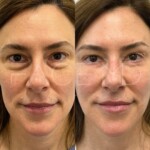
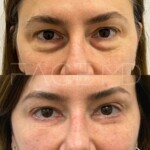
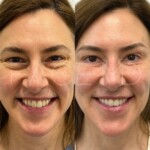
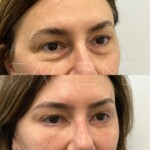
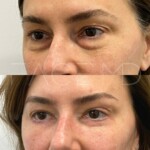
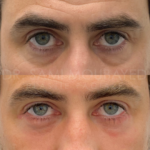
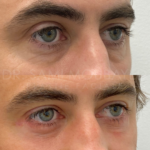

Warning: These photos are published as an indication to provide information on the nature of the intervention. They do not constitute a guarantee of results.
Source: Clinique Face MD.

























